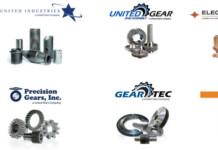
Hamilton Caster is a company on a lean journey, and this positions it well to understand and assist others on their lean journeys. When a major international engine manufacturer needed better carts for delivery of parts to an assembly line, the local distributor recommended Hamilton. Working closely as a team, the distributor, engine manufacturer, and Hamilton engineers designed a cart to meet multiple needs. Parts must be placed in the proper sequence for eventual use on different models, and are loaded in one facility, transported to the assembly facility, and then delivered via power towing to specified points on the line. Operators must be able to maneuver the loaded carts into position, then access the 48 parts while matching the part to the assembly on the line.
Using 12” diameter wheels with a Poly-Soft tread and precision ball bearings ensured easy rolling for the 2000-lb. capacity carts. Smaller wheels could have carried the load, but would have increased the force required to move the loaded carts. Poly-Soft tread is designed to be slightly softer than industry standard poly, yet it requires only about half of the pulling force to move, is quieter, and repels small particles that typically become embedded in softer tread wheels. For manual steering, needed to finesse carts into final position on the line, Hamilton designed a special bearing for the fifth wheel assemblies. Finally, convenient foot brakes allow operators to lock the cart in position on the line. To assist operators engaging and disengaging the brakes, Hamilton designed a very simply yet easy actuation pedal.
 Sequential loading assures the operator will have the right part at the right time. Ergonomically, parts must be in the acceptable reach “zone” for a variety of operators, with nothing either too high or too low. Rotating carrousels spin easily for part access without having to move the cart. Carrousels can be locked to prevent rotation during transit. Shelves in the carrousels slope slightly downward, away from the opening, to prevent parts from spilling out when the cart is moving, and each space is lined with UHMW material to protect part finish. In the event the carts require washdown, there is sufficient drainage provided at the center of each carrousel to prevent any pooling tendency.
Sequential loading assures the operator will have the right part at the right time. Ergonomically, parts must be in the acceptable reach “zone” for a variety of operators, with nothing either too high or too low. Rotating carrousels spin easily for part access without having to move the cart. Carrousels can be locked to prevent rotation during transit. Shelves in the carrousels slope slightly downward, away from the opening, to prevent parts from spilling out when the cart is moving, and each space is lined with UHMW material to protect part finish. In the event the carts require washdown, there is sufficient drainage provided at the center of each carrousel to prevent any pooling tendency.
Perhaps the single biggest factor in manually moving carts is the cart weight. To reduce the weight while preserving the structural strength required, Hamilton worked hard to eliminate any unnecessary material. Also, the carrousels are completely made of aluminum.
The carts are all towable, and feature towing tongues on the front and pintle hitches on the rear. Towing tongues use forged steel loops, the “business end” that handles the frictional wear and tear from towing. Forged steel loops provide years of dependable use. As many as six carts may be connected at a time into a “train.” Four-wheel steering enables the entire train to track in the same pathway around turns. For safety’s sake, the tongues can be stowed in the vertical position, held in place with magnets and hinged to prevent inadvertent drops. Lastly, Hamilton’s typical tie rod guards span the distance between front and rear wheels along each side. These protect the vulnerable tie rod, connecting front and rear axle assemblies, from damage by forklifts attempting to lift carts from the side.
 Versatility abounds in these trailers. The top section, with the carrousels, can be completely removed from the base units which include the running gear. These two assemblies are held together with four bolts, so removing the tops is relatively easy. Carrousel shelves are adjustable, permitting the manufacturer to move them to fit part changes in the future. Should a carrousel be damaged, design affords easy replacement.
Versatility abounds in these trailers. The top section, with the carrousels, can be completely removed from the base units which include the running gear. These two assemblies are held together with four bolts, so removing the tops is relatively easy. Carrousel shelves are adjustable, permitting the manufacturer to move them to fit part changes in the future. Should a carrousel be damaged, design affords easy replacement.
Manufacturing successfully in a lean environment means working toward one piece flow, minimizing walking and other wasted motions, presenting parts to workers in the best way, addressing ergonomic issues, structuring the work to minimize the likelihood of errors (poka yoke), and much more. These Hamilton carts play a key role in the lean assembly operation at an engine plant.
For ore information, please visit:
www.hamiltoncaster.com
Email:
info@hamiltoncaster.com
1637 Dixie Hwy • Hamilton, OH 45011
(800) 733-7655






















